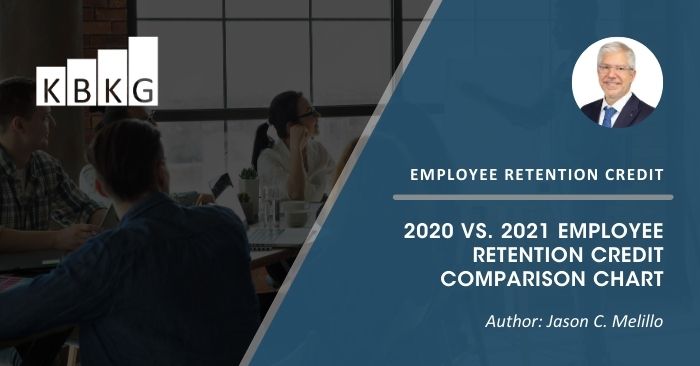Jason Melillo is a Principal and Local and Wage Based Incentive practice leader at KBKG. His areas of expertise are Local Incentives, Employment Tax Credits which includes Employee Retention Tax Credit, and other employment credits.
| Old Law | New Law | |
|---|---|---|
| Eligible Employers | 2020 | 2021 |
| Eligible employers can receive a refundable payroll tax credit of 50% of wages paid to employees between March 13th, 2020 and December 31st, 2020. | No Change | Eligible employers can receive a refundable payroll tax credit up to 70% of qualifying wages paid between January 1, 2021 and September 30, 2021. Recovery Startup Businesses that began operations after February 15, 2020 are eligible for up to $100,000 of credits on wages paid from June 1, 2021 through December 31, 2021. |
| An eligible Employer may not receive the Employee Retention Credit if the Eligible Employer receives a Small Business Interruption Loan under the Paycheck Protection Program that is authorized under the CARES Act (“Paycheck Protection Loan”). An Eligible Employer that receives a paycheck protection loan should not claim Employee Retention Credits. | This is no longer applicable. Employers that received a PPP loan can in fact qualify for the ERTC credit. | Employers may receive both a PPP2 loan and the Employee Retention Credit. |
| Eligible Employers Must Meet the Following Criteria: | ||
| Eligible Employers for the purposes of the Employee Retention Credit are those that carry on a trade or business during calendar year 2020, including a tax-exempt organization, that either: | ||
| Fully or partially suspends operation during any calendar quarter in 2020 due to orders from an appropriate governmental authority limiting commerce, travel, or group meetings (for commercial, social, religious, or other purposes) due to COVID-19; or | No Change | Eligible employers for the purpose of the Employee Retention Credit are those that carry on a trade or business duing the quarter in which the credit is determined. |
| Experiences a significant decline in gross receipts during the calendar quarter. | No Change. Requires a quarter that is less than 50% of the revenue when comparing against the same quarter in 2019 to qualify. | Employers that have revenue that is less than 80% of the revenue when comparing against the same quarter in 2019. Employers that were not in existence in 2019 would substitute 2020 for 2019 above. A reduction in Q4 2020 can qualify a company for Q1 2021. |
| Note: Governmental employers are not Eligible Employers for the Employee Retention Credit. Also, Self-employed individuals are not eligible for this credit for their self-employment services or earnings. | This section does not apply to any organization described in section 501(c)(1) of the Internal Revenue Code of 1986 and exempt from tax under section 501(a) of such Code, or (B) any entity that is a college or university, or the principal purpose or function of such entity is providing medical or hospital care. | |
| Definition of Qualified Employer Business | ||
| The operation of a trade or business may be partially suspended if an appropriate governmental authority imposes restrictions upon the business operations by limiting commerce, travel, or group meetings (for commercial, social, religious, or other purposes) due to COVID-19 such that the operation can still continue to operate but not at its normal capacity, or | No Change | No Change |
| A significant decline in gross receipts begins with the first quarter in which an employer’s gross receipts for a calendar quarter in 2020 are less than 50 percent of its gross receipts for the same calendar quarter in 2019. The significant decline in gross receipts ends with the first calendar quarter that follows the first calendar quarter for which the employer’s 2020 gross receipts for the quarter are greater than 80 percent of its gross receipts for the same calendar quarter during 2019. | No Change | An employer is an eligible employer with respect to any calendar quarter for which its gross receipts for the calendar quarter are less than 80 percent of its gross receipts for the same calendar quarter in 2019. Employers that were not in existence in 2019 would substitute 2020 for 2019 above. |
| Example: A state governor issues an executive order closing all restaurants, bars, and similar establishments in the state in order to reduce the spread of COVID-19. However, the executive order allows those establishments to continue food or beverage sales to the public on a carry-out, drive-through, or delivery basis. This results in a partial suspension of the operations of the trade or business due to an order of an appropriate governmental authority with respect to any restaurants, bars, and similar establishments in the state that provided full sit-down service, a dining room, or other on-site eating facilities for customers prior to the executive order. | No Change | Same as the 2020 law. |
| Credits Available | ||
| Employers who had 100 or fewer full-time employees in 2019, all employee wages are available for the credit calculation, regardless of whether the employee is still working or has been furloughed. | No Change | The maximum credit now applies to employers who had 500 or fewer average full-time employees in 2019. This was a significant change from the 2020 law. |
| Employers who had a larger average number of full-time employees in 2019, only the wages of employees who are furloughed or have reduced hours as a result of closure or reduced sales, are eligible for the credit. | No Change | Employers who have 500 or fewer full time employees in the prior quarter. This was a significant change from the 2020 law. |
| Credit Calculation | ||
| Wages, including health benefits, are capped at the first $10,000.00 in wages paid. Wages paid for compliance with FFCRA (paid family and medical leave) are excluded from the credit calculation. | No Change | Wages, including health benefits, are capped at the first $10,000 in wages paid “per quarter.” |
| Example by an Individual Employee | ||
| Employee was employed during the period of March 13, 2020, and December 31st, 2020. The credit is allowed against the employer portion of social security taxes under section 3111(a) of the Internal Revenue Code (the “Code”). | No Change | Employee was employed during the period January 1, 2021 to July 1, 2021. |
| Wages paid to employee through this period meets the threshold of $10,000 and includes employer/employee contributions to health care costs. | No Change | Wages paid to employee during the period above meets the threshold of $10,000 per quarter and includes employer contributions to health care costs as wages. |
| Employer is eligible to a 50% credit against payroll taxes, equaling up to a $5,000 credit per employee. | No Change | Employer is eligible to a 70% credit against payroll taxes, equaling up to a $7,000 credit per employee. |
| The credit equals 50% of the qualified wages (including qualified health plan expenses) that an Eligible Employer pays in a calendar quarter. The maximum amount of qualified wages taken into account with respect to each employee for all calendar quarters is $10,000 so that the maximum credit for qualified wages paid to any employee is $5,000. | No Change | The credit equals 70% of the qualified wages (including qualified health plan expenses) that an Eligible Employer pays in a calendar quarter. The maximum amount of qualified wages taken into account with respect to each employee for all calendar quarters is $10,000 per quarter so that the maximum credit associated to any employee is $7,000 per quarter. |
About the Author
 Jason C. Melillo – Principal
Jason C. Melillo – Principal
Pasadena
Jason Melillo is a Principal and Local and Wage Based Incentive practice leader at KBKG. His areas of expertise are Local Incentives, Employment Tax Credits which includes Employee Retention Tax Credit and other employment credits. » Full Bio


